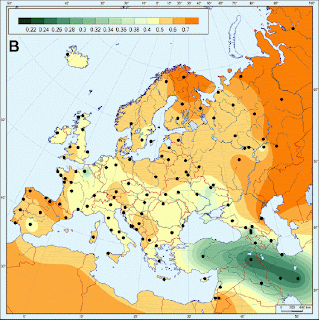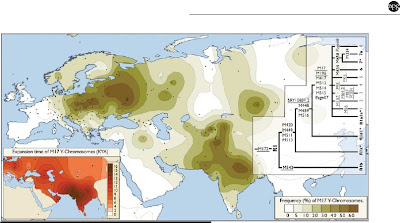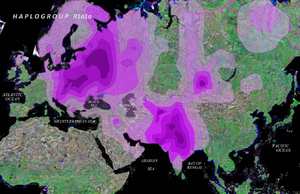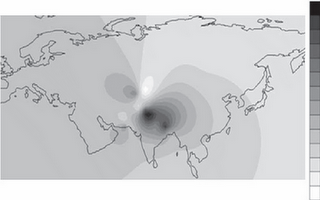In a previous post about genetics, I reported the discovery of a European branch of Y-DNA haplogroup R1a (named R1a1a7) which is "virtually absent in Asia", showing as impossible a recent migration to South Asia. In that study by P.A. Underhill, there was the hypothesis that this genetic group expanded in Europe during the Neolithic Linearbandkeramik culture, but it also noticed "a remarkable geographic concordance of the R1a1a7-M458 distribution with the Chalcolithic and Early Bronze Age Corded Ware (CW) cultures of Europe that prospered from ca. 5.5-4.5 KYA BP" (cp. the map above). It is then cited the finding of the burial in Eulau, Germany, belonging to the Corded Ware cultural horizon, dated around 2600 BC, because it gave for the buried males the haplogroup R1a (see the article by W. Haak Ancient DNA, Strontium isotopes, and osteological analyses shed light on social and kinship organization of the Later Stone Age). It is also interesting that the Corded Ware culture has been ascribed to Indo-Europeans by many scholars, probably for its area and since it is associated with wheeled vehicles, horses and metals:
"...Celtic, Germanic, Baltic and Slavic may possibly be traced back to the Corded Ware horizon of north, central and eastern Europe." (The Oxford Introduction to Proto-Indo-European and the Proto-Indo-European World (Oxford Linguistics) - J. P. Mallory and D. Q. Adams, 2006, p.452, Oxford University Press)Moreover, if we look at the variance of R1a1a7 (also in the map above), Poland appears as the place of origin, and the same is found for the CW culture: "Corded Ware ceramic forms in single graves develop earlier in Poland than in western and southern Central Europe. The earliest radiocarbon dates for Corded Ware come from Kujavia and Małopolska in central and southern Poland and point to the period around 3000 BC. Carbon-14 dating of the remaining central European regions shows that Corded Ware appeared after 2880 BC" (see here). Thus, a consistent picture seems to emerge from archaeology and genetics. However, the calculated age of R1a1a7 (before 8000 BC in Poland) suggested a connection with the Mesolithic or Linearbandkeramik periods.
But now we could have a counter evidence from another study, published in the November 2010 issue of PLoS Biology, Ancient DNA from European Early Neolithic Farmers Reveals Their Near Eastern Affinities, by the same W. Haak of the study about Eulau. This has revealed the genetic identity of ancient individuals belonging to the Linearbandkeramik culture, including a previous work on this archaeological horizon and a new analysis of skeletons from Derenburg in Germany (Harzkreis); it is mainly based on mitochondrial DNA, but also on chromosome Y. The results tell us that most of this agricultural people had a Near Eastern origin (see maps).
In the map above, you can see the genetic distance of modern populations from the mitochondrial data from Derenburg. The nearest populations are evidently in present Iran and Kurdistan. As we know from an important study by Metspalu and Kivisild, Iranian mtDNA is very different from Indian or South Asian DNA; Western Iran, also for the Y-DNA, is very similar to other Near Eastern countries, and Northern Iran has a strong influx from Anatolia (see the article by Regueiro). The presence of R1a1a is stronger in Southern and Eastern Iran (see also the article by Wells, that observes: "the population of present-day Iran, speaking a major Indo-European language (Farsi), appears to have had little genetic influence from the M17-carrying Indo-Iranians").
About mitochondrial haplogroups it is said in the study:
We found nine modern-day population pools in which the percentage of these haplotypes is significantly higher than in other population pools (p>0.01, two-tailed z test; Figure 1; Table S4): (a) North and Central English, (b) Croatians and Slovenians, (c) Czechs and Slovaks, (d) Hungarians and Romanians, (e) Turkish, Kurds, and Armenians, (f) Iraqis, Syrians, Palestinians, and Cypriotes, (g) Caucasus (Ossetians and Georgians), (h) Southern Russians, and (i) Iranians. Three of these pools (b–d) originate near the proposed geographic center of the earliest LBK in Central Europe and presumably represent a genetic legacy from the Neolithic. However, the other matching population pools are from Near East regions (except [a] and [h]), which is consistent with this area representing the origin of the European Neolithic, an idea that is further supported by Iranians sharing the highest number of informative haplotypes with the LBK (7.2%; Table S4).
About Y DNA haplogroups:
The Y chromosome hgs obtained from the three Derenburg early Neolithic individuals are generally concordant with the mtDNA data (Table 1). Interestingly, we do not find the most common Y chromosome hgs in modern Europe (e.g., R1b, R1a, I, and E1b1), which parallels the low frequency of the very common modern European mtDNA hg H (now at 20%–50% across Western Eurasia) in the Neolithic samples. Also, while both Neolithic Y chromosome hgs G2a3 and F* are rather rare in modern-day Europe, they have slightly higher frequencies in populations of the Near East, and the highest frequency of hg G2a is seen in the Caucasus today. The few published ancient Y chromosome results from Central Europe come from late Neolithic sites and were exclusively hg R1a. While speculative, we suggest this supports the idea that R1a may have spread with late Neolithic cultures from the east.
So, we can suppose that R1a arrived with the Corded Ware culture, which was an important cultural change in Europe. After the Near Eastern population which had already colonized the Balkans, the Corded Ware people found in Eulau came from the East, bringing the new 'Indo-European' culture. Interestingly, the mitochondrial haplogroup of the mother in the family buried in Eulau was K1b, which "has uniquely been reported in two modern Shugnans of Tadzhikistan" (Dienekes' quotation). Wells reports 23% of R1a1a for Shugnans, and 68% for their neighbors Ishkashimis (living both in the upper Oxus valley). In this context, it is impressing to observe that in Tajikistan we also find striking parallels to the burial rituals followed by the Corded Ware culture, in the Vakhsh and Beshkent cultures: the bodies laid on their sides, hunched up, with arms bent at the elbow and legs at the knee, men on the right side, and women on the left side. In the Beshkent culture, the orientation is often east-west. Moreover, according to the anthropologist Carleton S. Coon, the skull type of the Corded Ware burials is very close to the present Irano-Afghan type.
Shugnans and Ishkashimis speak both an Iranian language, and they live in the cradle of Iranian culture, mentioned in the Avesta. We can suppose that the Oxus valley was an ancient seat for the R1a1a people coming from South Asia, and that they spoke an Indo-European language. From Central Asia they should have moved to the Kurgan area in Ukraine, and from there to Central Europe. Another R1a1a people went eastward up to the Tarim Basin (see here) and another to the Andronovo area near Krasnoyarsk in Siberia (see here). But we know that they all had their ultimate origin in western South Asia, and their expansion in Eurasia seems to be dated particularly in the metal age, since all these cultures knew metals. As recognized by some scholars, calculated ages of R1a1a appear as too high, and the archaeological record can help us to correct them. According to this picture, we can see the Neolithic of the Indus-Sarasvatī basin and probably of the adjoining 'Iranian' regions as the source of the Indo-Europeans, who developed so many prehistoric and historical civilizations of Europe and Asia.
Shugnans and Ishkashimis speak both an Iranian language, and they live in the cradle of Iranian culture, mentioned in the Avesta. We can suppose that the Oxus valley was an ancient seat for the R1a1a people coming from South Asia, and that they spoke an Indo-European language. From Central Asia they should have moved to the Kurgan area in Ukraine, and from there to Central Europe. Another R1a1a people went eastward up to the Tarim Basin (see here) and another to the Andronovo area near Krasnoyarsk in Siberia (see here). But we know that they all had their ultimate origin in western South Asia, and their expansion in Eurasia seems to be dated particularly in the metal age, since all these cultures knew metals. As recognized by some scholars, calculated ages of R1a1a appear as too high, and the archaeological record can help us to correct them. According to this picture, we can see the Neolithic of the Indus-Sarasvatī basin and probably of the adjoining 'Iranian' regions as the source of the Indo-Europeans, who developed so many prehistoric and historical civilizations of Europe and Asia.









